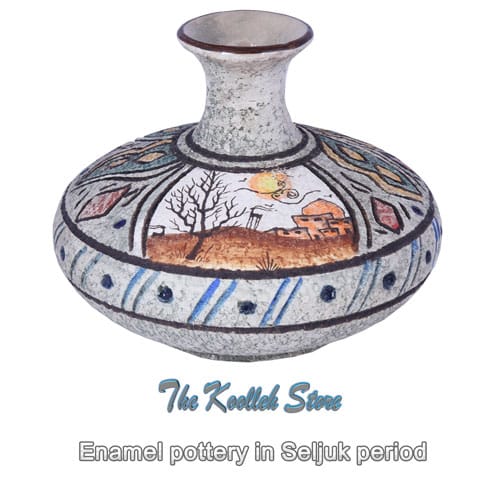Enamel pottery in Seljuk period

Twelfth-century Seljuk potters revived the technique of polishing pottery, which was common in the ninth century during the Abbasid period. The color of Iranian jade dishes is varied in the Seljuk period and can be seen from pale green to dark brown on white glaze. Sometimes blue or turquoise blue is also used, and this color can be found on several plates and watercolors in the Metropolitan Museum. The utensils and tiles used to decorate the walls and altars were decorated with beautiful and different interpretations, and the images of animals and birds, plant shapes and inscriptions, especially for the altar, were engraved on them. Human forms were also common, including hunting scenes and people sitting alone or in groups, often depicting a prince and his entourage. In one of these vessels, which is perhaps the oldest pottery of the twelfth century (sixth century AH), decorative shapes have been used in the field of one-handed executioners.
Some of the oldest pieces of history, the oldest of which is a bottle dated 575 AH (1179 AD) in the British Museum, show that the method of polishing pottery was quite common in the twelfth century. The decoration of this dish is the shapes of sitting people and running animals and the shapes of large stretched vegetable plants and the example of this dish is in Chicago Industrial Institute, which is dated 587 AH (1191 AD) in both of these dishes. Placed in the polishing field. The style of these twelfth-century pieces is quite different from the style of jade dishes and historic tiles of the first half of the thirteenth century.
The Metropolitan Museum has several bowls and a piece of tile that is similar in style to the bottle in the British Museum, which dates back to 1179 AD (575 AH). One of the highest parts of this group is the dish in which the image of the winged horse Pegasus (from Greek mythology) is engraved on the background of vegetable shapes with Seljuk style. Other important pieces of this group are the vessel on which the image of a bird and a sitting person are drawn and a piece of tile on which the shape of an ear donkey is engraved. Since many pieces of this group and other pieces have been found in the 12th century Seljuk style in Rey, they can all be considered the product of that important pottery center.
Rey’s pottery, decorated with the image of a rider and seated people and the natural landscape of trees in the shape of four houses, can be attributed to the late twelfth century.
In the bottle made in 1179 (575 AH) and the plate made in 1191 and other similar parts, plant shapes and palm leaves and leaves play a role in the decorative design in the field of personal images. In some parts of Rey’s construction, these tourist and vegetable forms form a busy design that is combined with human images. An example of such a design is on a large plate (Figure 1) found in the Metropolitan Museum. This dish is not only one of the best examples of Ray’s product, but also a masterpiece of the Iranian pottery industry. The image shows two people, one a prince or an emir and the other a sea urchin playing a cymbal, and these two images have occupied the entire surface of the vessel except the narrow margin. The design is round with large images and is embossed with vegetable floral shapes. The clothes of these two people are also decorated with decorative shapes and dotted lines. Another prominent feature of this dish, which is also evident in Raqqa pottery, is that the images are separated and spaced by two clear lines from the plant forms in the background. One of these lines is plain and the other is white. Its outstanding drawing and mineral polish show that this dish was made in one of the court workshops.
Glazing vessels of the second half of the twelfth century elevated the Seljuk style to its highest level. In 1193 (590 AH), the city of Rey fell to the kings of Khwarezmshahi and they preserved the industrial customs of the Seljuk period. The style of 13th century pottery is evident in the large number of pottery and historical tiles, the oldest of which is a star-shaped piece of tile preserved in the Museum of Islamic Industry in Cairo, dating to 600 AH (1203 AD).
The design of the parts made in the 13th century (7th century AH) is the abundance of small-scale decorative shapes and images of animals and birds that cover the surface of the dish and the lines around the large and clear images are drawn. Examples of such pottery include the following tiles and tiles: 1208 (605 AH) and 1210 (607 AH) tiles in the Boston Museum and Jami 607 AH (1210 AD) in the Havier Collection of the Metropolitan Museum and a piece Tile 1212 in the Anderson Collection in Cairo. The background and clothes of the people in these dishes are painted with spiral and twisted lines with polished paintings or on the executioner’s background. These snail lines resemble the shapes of palm leaves in 12th century decorations.

